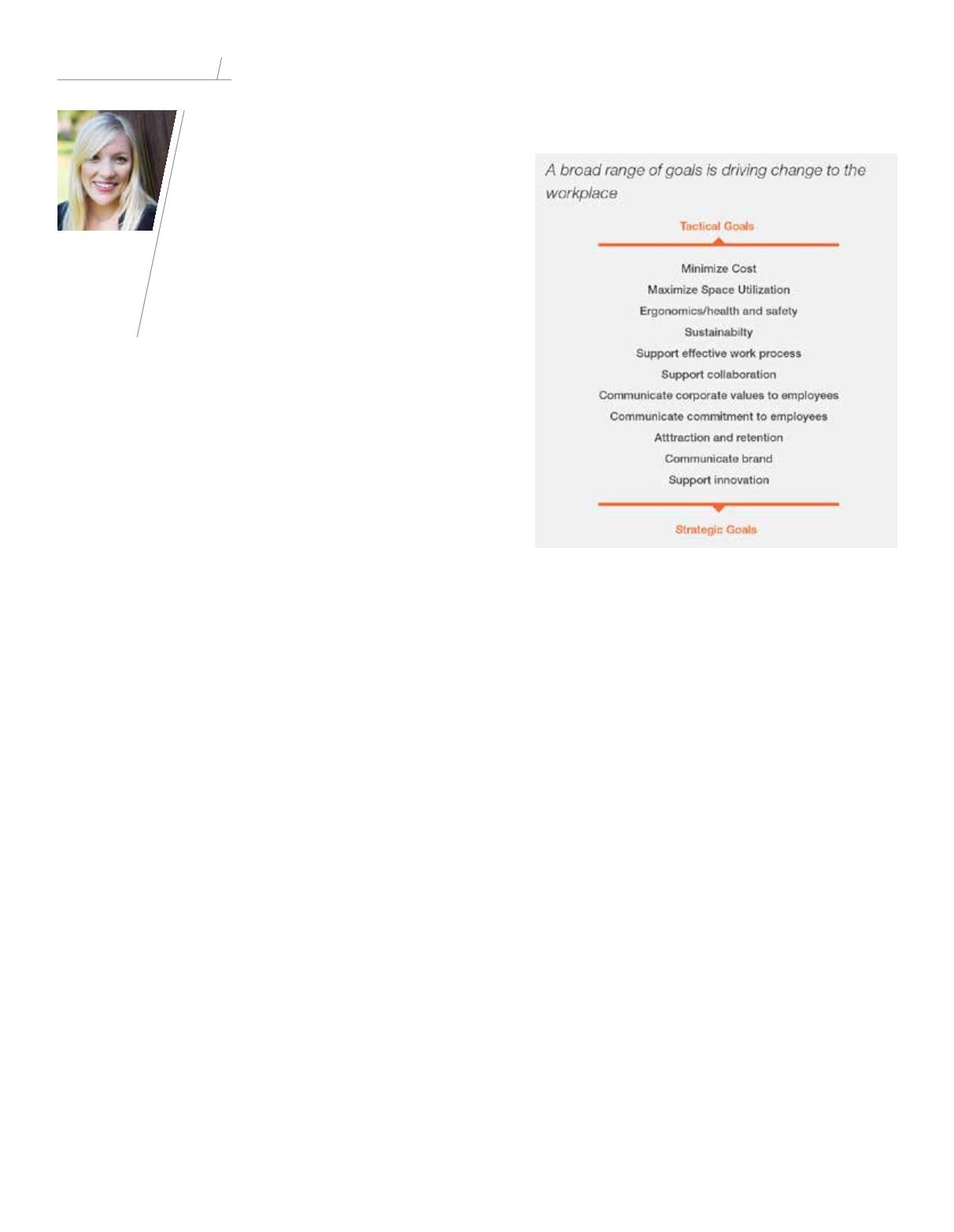

18
/ BUILDING DIALOGUE / JUNE 2017
Align Behavioral Norms with Strategic InitiativesW
e all know that workplace strategy fa-
cilitates the intentional alignment of an
organization’s environment with cultur-
al work patterns to amplify peak business perfor-
mance – all while appropriating cost and increas-
ing innovation to fit both the current condition
and future state.
As you may have experienced, these two select
phrases “cultural work patterns” and “peak busi-
ness performance” may occasionally be progressing
in varying directions. An organization’s behavioral
norms must be in alignment with strategic initiatives,
as Wayne Gretzky puts it: “Skate to where the puck is
going.”
Workplace strategy conversations often are sparked
when the business at hand is either running out of
work space, has too much real estate or wants to in-
troduce organizational evolution through the envi-
ronment.
Peak business performance is uniquely defined by a
spectrum of business objectives, ranging from tactical
needs like minimize cost and maximize space utili-
zation, to increasingly strategic goals such as support
effective collaboration, communicate brand and sup-
port innovation. As you may expect, a broad range of
diverse disciplines (both internal and external to the
organization) contribute to define what “successful
criteria” means to them at the time. While it is likely
quite clear where an organization is headed through
ongoing executive level business planning sessions,
another salient factor of work often is amorphic in na-
ture with less controlled measurement and structured
prediction efforts: work patterns.
There are many tactics for organizations to detan-
gle and analyze their own work patterns to predict a
better future. To glean learning from local, national
and global organizations, here are some broad ideas
to consider when analyzing your own organization’s
cultural norms.
As a workplace professional, you have valid insights
into what is working within your own organization
and how the work experience might need to evolve.
But beyond your intuition and personal experiences,
how do organizations capture an authentic voice of
their employee base to better inform their workplace
strategy?
Workplace assessment methodologies that contrib-
ute meaningful data to the conversation can include
space observations and in-person interviews, camera
journal assignments, employee surveys, utilization
studies, change readiness analysis, pre- and post-oc-
cupancy surveys, workforce forecasting and organiza-
tional analysis. With experienced professionals from
real estate, strategy and design consultancies, you can
start with creating a “workplace balanced scoreboard”
of metrics.
These metrics should be relevant to the intentions
of the design and the organization’s business objec-
tives that reflect financial, behavioral, work process,
health or other outcomes pertinent to the business.
Best Practices for a Successful
Workplace Assessment
“Less is more.”
Select the fewest, highest-impact
KPI (key performance indicators) possible. Similar
to a well-written survey, be prepared to do some-
thing with the results. Do not collect data unless you
know in advance exactly how you plan to use it.
Establish baseline measures.
Baseline measures estab-
lish a reference point against which you can assess
the success of changes made to the workplace over
time.
Use survey data collection and in-person interviews
to
measure employees’ perceptions of behaviors relat-
ed to project goals, such as comfort, degree of collab-
oration, quality of group decision-making, etc. Gath-
er data in a way that keeps responses confidential,
yet can be evaluated by satisfaction level, by teams
or departments, new hires vs. tenured staff, etc.
Collect objective benchmarks
from other sources,
such
as HR databases for attraction and retention rates,
health claims rates and costs, or other metrics that
are related to financial outcomes.
Collect data on an ongoing basis
(quarterly or semi-
annually). This will provide an ongoing stream of
objective information that can keep the workplace
design aligned with employee needs and business
goals.
Keep the reports simple.
This will enable everyone to
understand the results and thus be able to act on
them.
Remember to manage the “human side” of the project.
A
technically successful assessment program can still
fail if people don’t buy in to the effort. Ensure that
Moving Forward
Jenny West,
LEED AP ID+C
Business De-
velopment
Manager,
Knoll
Participants ranked the importance of 11 business/
facilities goals
















